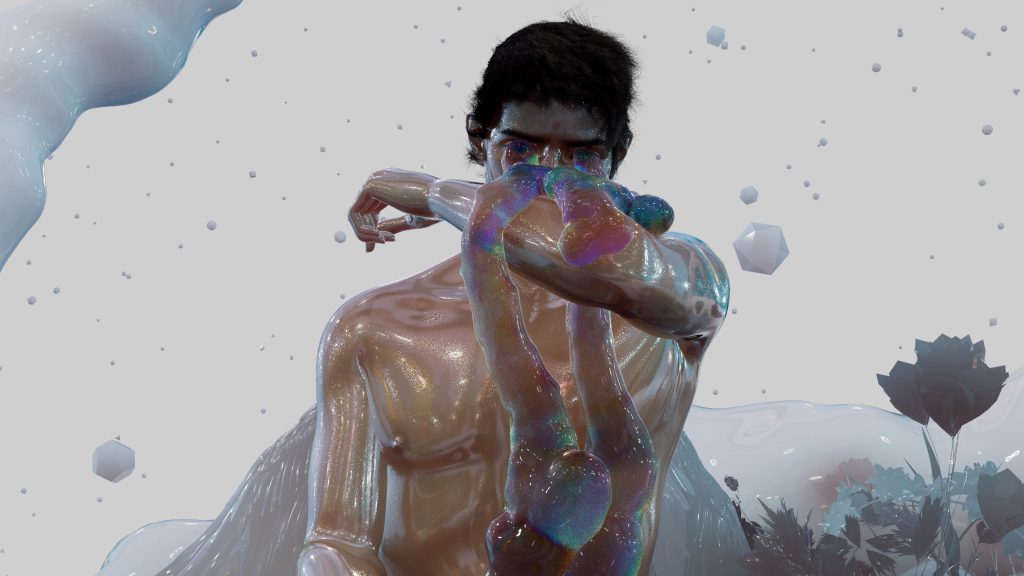Bassam Al-Sabah explains to Canvas how he uses CGI to construct digital worlds that question our understanding of reality.
What first drew you to using digital media and CGI in your work?
I lived in Iraq until the age of 10. As kids, our parents didn’t let us play outside that much so my sister and I played a lot of video games. There is an element of creativity through the stories that are told through animation, video games or even a board game. I’ve always been enamoured of this idea of world building, and of being able to create a fantasy that feels real. Moving image has a way of telling a story or communicating a feeling, but I had no interest in filming. Partly because there are so many things happening in my mind that I feel that I can’t translate them physically – there’s something about a kind of shimmery skin or a certain texture, or a figure convulsing. Over time, I began to explore building this entire world from the beginning and creating a space that feels unstable.
With CGI these digital elements can exist in an infinite realm, yet some of your works deal with very temporary and organic subjects such as death and decomposition.
My skills have gotten better over time, but a part of me never wants to commit to realism. I take it 90 per cent of the way there, where the bodies seem to move smoothly or the hair looks like hair, and then I use the remaining 10 per cent to play and create this world. There’s this tension and beauty in building something that transfers to the real world. My films also build quite slowly. Decomposition means death. It’s slightly gross, but I’m animating these dead figures so there is this juxtaposition. My film Wandering, wandering with a sun on my back (2018) has this scene where a bunch of flowers starts convulsing and the flowers feel as if they have a life of their own. There is an element of playfulness in that you can create the essence of something, but I’m not trying to represent something. I’m playing with the idea of it and abstracting it into something else.
By avoiding being too real or too human, do you feel that this allows you more freedom to discuss certain topics?
Yes. Because it isn’t real, you do have this freedom, but in that freedom there’s also a trap. Sometimes it can be so overwhelming. There is this space to play around with all of these emotions and aesthetics. Every time I start a new project, I sit at the computer, open a programme and it’s blank. What are we building today? Is it a landscape? Is the figure in a void? I’m not only interested in the visual of fabrication of these worlds, but also in the emotions that come with them.

What have the reactions been to your films?
It depends on the exhibition context or the work people are seeing. My work has shifted in the last few years. There’s one film that I made that gets the most emotional response. My sister’s an architect and together we remade our house in Iraq with CGI software in a work called Fenced within the silent cold walls (2018). As you move through the space, it’s really empty and then things start to convulse and come out of the TV or radio. At the end, my grandmother speaks for two minutes about being in the house alone before she joined us in Ireland. It was a real film about the loss of a life that my grandmother thought she had or wanted to have in the future. I think that gets the most emotional response, particularly from people from the Middle East, because this story about losing a home is relatable to so many. My later works pull away a little bit from being autobiographical, because I wanted there to be some distance between me and the work, so if someone doesn’t know my story, the work can still hold its own.
Your film I AM ERROR (2021), commissioned by Gasworks, is much longer than your others.
I’m interested in making works that become circular, so that you can join halfway through and create a narrative based on where you came into the film. They almost loop in a way that I think trauma feels like a loop, where you’re always replaying the experience. The length of I AM ERROR is just over 30 minutes and it really allowed me to create something unstable. There are so many different scenes and aesthetics of landscapes and video games that interweave, yet every scene has its own identity.
Does your new film IT’S DANGEROUS TO GO ALONE! TAKE THIS (2021) connect to your previous films?
It’s a sort of continuation of the show that was at Gasworks, almost as part two. One thing that I’ve found is that I never feel that I’ve completely gotten all of the work out through one project. Over the last three or four years, I will work on a project, but maybe split the film into two. So you have two parts of the same idea, as opposed to always feeling as if I have to create this huge amount of content in a small period of time.
This interview first appeared in Canvas 105: Out of This World



